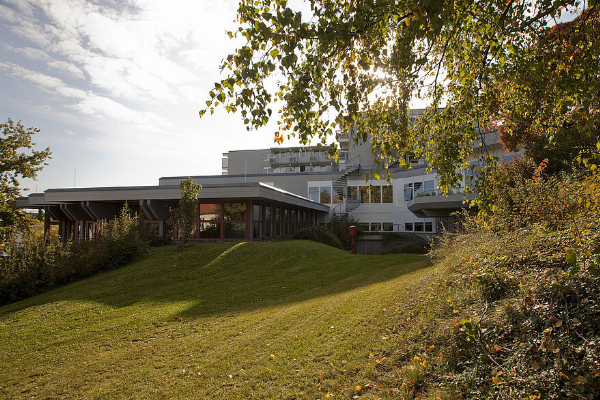Schussental-Klinik

Safranmoosstraße 5
88326 Aulendorf
Phone:
07525-9320
Fax:
07525-93-2737
Mail:
ed.kinilk-latnessuhcs@ks-ofni
- Number of beds: 82
- Number of specialist departments: 1
- Number of inpatient cases: 766
- Hospital owners: Schussental-Klinik gGmbH
- Type of provider: öffentlich
Further information
| Bezeichnung | |
| Teilnahme externe Qualitätssicherung | yes |
- Quality of participation in the Disease Management Programme (DMP)
No participation
- Implementation of the minimum quantity agreement
No participation
- Implementation of resolutions of the Federal Joint Committee on quality assurance (G-BA)
No participation
- Clarifying chat completed: no
- Clarifying chat not completed: no
- No participation in clarifying chat: no
- Notification of non-fulfilment of nursing care not made: no
| Number | Group |
|---|---|
| 10 | Medical specialists (m/f) , psychological psychotherapists (m/f) and child and adolescent psychotherapists (m/f) who are subject to the obligation to undergo further training* |
| 9 | Number of medical specialists (m/f) from no. 1 who have completed a five-year period of further training and are therefore subject to the obligation to provide evidence |
| 9 | Number of those persons from no. 2 who have provided proof of further training according to Article 3 of the G-BA regulations |
According to Section 4 (2) of the Quality Management Guideline, facilities must provide for the prevention of and intervention in cases of violence and abuse as part of their internal quality management. The aim is to prevent, recognise and respond appropriately to abuse and violence, particularly against vulnerable patient groups such as children and adolescents or people in need of help, and also to prevent it within the facility. The respective procedure is aligned with the size of the facility, the range of services and the patients in order to define customised solutions for sensitising the teams as well as other suitable preventative and interventional measures. These may include information materials, contact addresses, training/education, codes of conduct, recommendations for action/intervention plans or comprehensive protection concepts.
- Is a protection concept in place? Yes
- Measures
-
Prevention
- Last review of the measure
11.03.2024 20:04:21
- Last review of the measure
-
Prevention
- Drug commission
Training of employees on AMTS related topics
Geschäftsordnung Qualitätsmanagement, (letzte Aktualisierung 15.03.2021); "Risikoinventarliste Gesamt"
30.04.2023
Electronic support for the admission and anamnesis process (e.g. import of patient master data or medication plans, use of a drug knowledge database, input screen for drugs or anamnesis information)
„Pflegestandard – Umgang mit Medikamenten/ BTM“ Erstellungsdatum ist der 06.05.2024; Dienstanweisung „Verordnen und Verabreichen von Medikamenten“
31.05.2024
Possibility of electronic prescription i.e. structured entry of active substances (or name of the preparation), form, dose, dose frequency (e.g. in the HIS, in prescription software)
Provision of one or more electronic drug information systems (e.g. Lauer-Taxe®, ifap klinikCenter®, Gelbe Liste®, Fachinfo-Service®)
- Bereitstellung einer geeigneten Infrastruktur zur Sicherstellung einer fehlerfreien Zubereitung
- Anwendung von gebrauchsfertigen Arzneimitteln bzw. Zubereitungen
- Vorhandensein von elektronischen Systemen zur Entscheidungsunterstützung (z.B. Meona®, Rpdoc®, AIDKlinik®, ID Medics® bzw. ID Diacos® Pharma)
Electronic documentation of the administration of drugs
- Fallbesprechungen
- Maßnahmen zur Vermeidung von Arzneimittelverwechslung
- Teilnahme an einem einrichtungsübergreifenden Fehlermeldesystem (siehe Kapitel 12.2.3.2)
- Aushändigung von arzneimittelbezogenen Informationen für die Weiterbehandlung und Anschlussversorgung der Patientin oder des Patienten im Rahmen eines (ggf. vorläufigen) Entlassbriefs
- Aushändigung von Patienteninformationen zur Umsetzung von Therapieempfehlungen
- Aushändigung des Medikationsplans
- bei Bedarf Arzneimittel-Mitgabe oder Ausstellung von Entlassrezepten
- Admission to hospital, including anamnesis
; Instruments and measures are presented for determining the old medication (drug history), the subsequent clinical assessment and the switch to the medication available in the hospital (house list), as well as for documenting both the patient's original medication and that for hospital treatment adapted medication.
- Medication process in the hospital
In this context, the following sub-processes are assumed as examples: drug history - prescription - patient information - drug delivery - drug use - documentation - therapy monitoring - result assessment. Instruments and measures for safe medication prescription can be presented, e.g. B. in terms of readability, clarity and completeness of the documentation, but also in terms of area of application, effectiveness, benefit-risk ratio, tolerability (including potential contraindications, interactions, etc.) and resource considerations. Information can also be provided to support reliable medication ordering, delivery and use or administration.
- Discharge
In particular, the measures taken by hospitals can be presented to ensure that information on drug therapy is structured and passed on to doctors and physicians providing further treatment, as well as the appropriate provision of patients with drug information, medication plans and medications. Drug prescriptions are made.
Job
Explanation
Hamburger Fernhochschule, Studienzentrum Stuttgart; Fachbereich Gesundheit und Pflege; Dozentur am Universitätsklinikum Ulm
FL03 - Student training (clinical traineeship / internship year)
Explanation
Explanation
Universitätsklinikum Ulm; McGill University, Montreal, Kannada
- Hospital staff
- Explanations: Belieferung durch die Apotheke des ZfP Südwürttemberg und Betreuung über das pharmazeutische Personal der dortigen Apotheke
Christine Dotzlaff
Qualitätsmanagementbeauftragte
Safranmoosstraße 5
88326 Aulendorf
Phone:
07525
-93-2722
Mail:
ed.kinilk-latnessuhcs@ffalztod.enitsirhc
Christine Dotzlaff
Qualitätsmanagementbeauftragte
Safranmoosstraße 5
88326 Aulendorf
Phone:
07525
-93-2722
Mail:
ed.kinilk-latnessuhcs@ffalztod.enitsirhc
Dr. med. Nikolai Köppelmann
Medizinischer Geschäftsführer
Safranmoosstraße 5
88326 Aulendorf
Phone:
07525
-93-2666
Mail:
ed.kinilk-latnessuhcs@nnamleppeok.ialokin
Magdalene Ciurus
Ärztín
Safranmoosstraße 5
88326 Aulendorf
Phone:
07525
-93-2776
Mail:
ed.kinilk-latnessuhcs@suruic.eneladgam
Simone Nagel
Ansprechpartnerin für Menschen mit Beeinträchtigung
Safranmoosstraße 5
88326 Aulendorf
Phone:
07525
-93-2728
Mail:
ed.kinilk-latnessuhcs@legan.enomis
88326 Aulendorf
Phone:
07525-9320
Fax:
07525-93-2737
Mail:
ed.kinilk-latnessuhcs@ks-ofni
Constanze Droste
Pflegedirektion
Safranmoosstraße 5
88326 Aulendorf
Phone:
07525
-93-2900
Mail:
ed.kinilK-latnessuhcS@etsord.eznatsnoc
Barbara Kibele
Verwaltungsleitung
Safranmoosstraße 5
88326 Aulendorf
Phone:
07525
-93-2725
Mail:
ed.kinilK-latnessuhcS@elebiK.arabraB
Kerstin von der Heiden
Geschäftsführung
Safranmoosstraße 5
88326 Aulendorf
Phone:
07525
-93-2700
Mail:
ed.kinilK-latnessuhcS@nediehrednov.nitsrek
Dr. med. Nikolai Köppelmann
Medizinischer Geschäftsführer
Safranmoosstraße 5
88326 Aulendorf
Phone:
07525
-93-2666
Mail:
ed.kinilk-latnessuhcs@nnamleppeok.ialokin
IK: 260841597
Location number: 772653000
